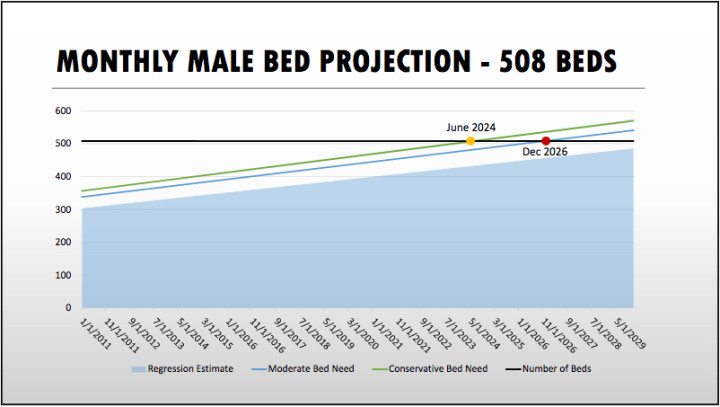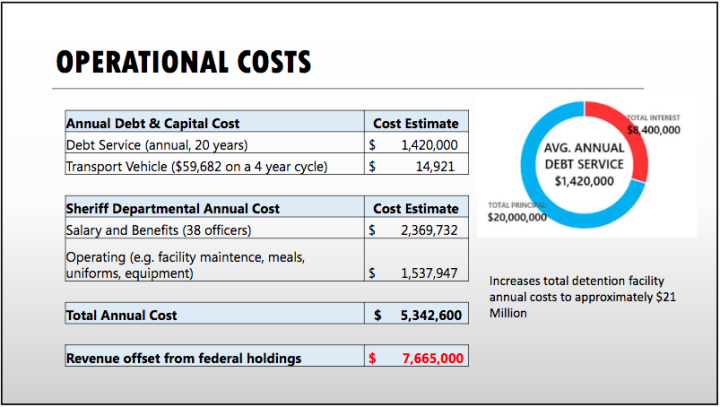As the Buncombe County Detention Facility nears critical mass, county commissioners could be forced to make a decision on expansion sooner rather than later.
“Here’s the kicker … if you decide today, it’s still 24 to 36 months out before you have something operational,” Sheriff Van Duncan told commissioners during a presentation on Oct. 10. The county might be able leverage federal dollars to help offset construction of a new campus or expansion of the existing facility.
The BCDF, located in downtown Asheville, has 604 beds in 13 housing units, with capacity for 508 males and 96 females. Different housing units separate genders and compartmentalize prisoners with violent tendencies and with sexual predator convictions. Operating the facility takes 172 staff members whose salaries total $12.1 million and necessitates a $3.6 million operating budget.
While the BCDF has 604 beds, Duncan noted that in the past they’ve received permission for “double-bunking,” a move that allows the facility to exceed its normal limits, but immediately noted it’s “not a good thing.”
So who’s filling up the jail? Sixty-six percent of inmates (355) are awaiting county trial, 19 percent (99) are being held for the feds, 8 percent are carrying out local sentences (44), 3 percent (17) are state prisoners and 4 percent are labeled as “other,” according to data from the first six months of this year provided by the county.
Duncan noted the reason the BCDF is attractive for housing federal inmates is because it meets federal criteria and has proximity to the federal courthouse in downtown Asheville. At any given time, there are 90 to 100 such inmates at the jail, and the federal government pays $100 per day, per prisoner. Duncan said that leads to about $3 million per year, money which goes to the county’s general fund.
Meantime, female capacity at the BCDF is marching toward a tipping point. It already experienced peak population a few times last year, which resulted in authorities having to transfer some prisoners to other facilities. That comes at a cost of upward of $65 per prisoner, per day, according to county staff.
A moderate model by county analysts shows those peaking issues becoming more frequent. “What we expect is that coming toward November 2020, we will be doing [female prisoner transfers] more frequently. After 2020 it will be standard practice,” said Lee Crayton, a county management analyst, noting the conservative predictive model shows the problem landing on June of last year.
While not as urgent a problem, the BCDF’s male population is also trending toward running out of room. A conservative model shows bed space peaking becoming an issue in 2024, and the moderate forecast predicts 2026.

To alleviate the pressure, county staff says the facility needs a variety of diversion programs coupled with some form of expansion. A third option would be to make transporting those peak prisoners the standard operating procedure, a move that would not likely be financially sustainable and could be logistically impossible. “I don’t know how realistic that is. Female space across the state is at a premium,” noted Duncan.
Some immediate relief can come via pretrial diversions in an attempt to expedite the local pretrial population, the largest lump sum of daily inmates. That means moving people toward mental health and substance abuse programs and tapping into technology to catalyze the pretrial process. It could even mean lobbying the state to loosen child support laws that have absentee payees thrown into detention.
Currently, two expansion options are on the table. One plan is to build a separate female jail somewhere in the county, which would then turn the BCDF into a dedicated male facility. The second path forward would be expanding the BCDF, a move county staff says would cost more in finances and time.
The separate female facility being proposed would be modular construction, allowing it to grow as necessary, according to Planning Director Jon Creighton. Initially, it would have 190 beds, with an estimated price tag of $20 million over 20 years. Annually, between debt service, salaries and other costs, it would set the county back about $5.3 million, according to county estimates.
County staff noted that a dedicated female jail would also free up beds in the BCDF for more federal inmates to the tune of about double the current occupancy, which would produce an estimated net increase of upward of $3.8 million, for a potential total of $7.6 million in federal paybacks. Duncan said contract renegotiations are on the horizon and he’s hopeful that will bring in a bigger payout, potentially $130 per day, per inmate. He also added that the feds have told him they have an “immediate need” for at least 50 more inmates per day at the BCDF.

“It’s hard to evaluate which scenario is the best course and to what extent we can forecast how much impact diversion will have,” said Commission Chair Brownie Newman.
Commissioner Ellen Frost added, “We can keep building or we can look at what other places have done. If we don’t change patterns, we are going to be building again in the future.”
Commissioners did not take any action on the issue. But, as Duncan noted, the clock is ticking, because after commissioners formally adopt a solution, it will still be two to three years before a new facility is ready for intake.
In the long run, it looks to be an issue that will continue to compound. County staff estimates that even with building a separate female facility and having all 604 BCDF beds dedicated for men, conservative forecasting suggests by 2026 bed space will once again be an issue. The moderate model predicts a problem by 2029.




Females… *gasp*… criminals? In Asheville? God forbid, equality!
What exactly does it mean when the article said that Sheriff Van Duncan said that the feds told him they were in “immediate need” of 50 more inmates per day at the BCDF??!!? Like does that mean they gotta go around and makeup 50 more bullsh*! charges on people? Or find more pedestrians to beat down for “jaywalking”?
Hi Tara,
Thanks for your inquiry. I can see how that phrasing could be interpreted to mean that the Bureau of Prisons had ordered the sheriff’s department to round up more prisoners. The intent is this: the Buncombe County jail receives federal money for housing federal prisoners in the local detention facility and Duncan’s staff had been told that the feds had “immediate need” for housing for 50 more prisoners. So the staff was showing a potential income opportunity for jail space that would be freed up by a separate, dedicated female facility.
-Xpress
Lol ahhhhh! I see now! Thanks for taking the time to reply!